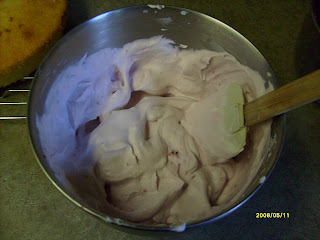The first recipe is from Jim Lahey's no knead bread cookbook, which I was perusing one day while throwing together the ingredients for bread. I thought I would try something different, and I happened to have plenty of carrots, so I made:
Carrot Bread
The odd thing about this recipe is that it really isn't so much about the carrots at all. It calls for all sorts of interesting ingredients, including currants (which, oddly enough, I also had on hand), walnuts, and cumin seeds as well.
bread flour- 3 cups
salt- 1 1/4 tbsp
dry active yeast- 1/4 tbsp
freshly squeezed carrot juice- 1 1/2 cups
currants- 3/4 cup
coarsely chopped walnuts- 3/4 cup
cumin seeds- 1 tbsp
Here's how it looked throughout the process:
Step 1- : process the carrots for carrot juice
Step 2- Put the carrots through the food mill to extract the carrot juice.
(I used the leftover carrot pulp the next day on a salad-- but I kind of wish it had been in the bread).
Step 3- Add the carrot juice and some pulp to the usual mixture of bread ingredients.
Step 4- Once it's well mixed, leave it to rise for 18 to 24 hours.
Step 5- Meanwhile, observe while your friends blow up a dingy in your living room. Go for a paddle on the river, dragging the dingy behind your canoe (this step is optional).
Step 6- Once the dough has risen, knead it as much or as little as you wish—I like to deviate from the recipe and knead it quite a bit, which I find makes a softer bread. Then I let it rise for another hour or so before baking. Bake at 375 in a covered pot or pan of your choice until the crust is dark brown (I used aluminum foil over my bread pan).
Ta da! Lovely orange carrot bread. To be honest, this bread was surprisingly lacking the flavour department. It was good, but it wasn’t the best.
Not like this one:
Currant & Spice Bread
If the first bread was the kind where I find a recipe that suits what I have on hand, this is definitely the kind where I just make it up as I go along.
I had decided to do one normal loaf, and another experimental one. On a whim, I grabbed the jar of dried currants I that had been sitting on the shelf for a while, and threw those in along with some cinnamon and cloves, and a bit of sugar. The result was way better than I had expected! It might have also had something to do with the mixture of flours I used, but who knows, really.
1 cup bread flour
1 cup whole wheat flour
1 cup spelt flour
1 1/4 tsp salt
1/2 tsp yeast
1 1/3 cups cold water
about 1 cup of dried black currants
1 tsp ground cinnamon
1/2 tsp ground cloves
1 or 2 tbsps of brown sugar, honey, or maple syrup
The process is really the same as above (after the carrot juice part) so I'll skip all of the work. Here is the finished product next to a loaf of 9-grain bread that was made at the same time.
And that's all for this lesson in bread-making. Stay tuned for the ins and outs of homemade Lamb Tourtiere!



















